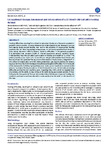Occupational Therapy Assessment and Intervention of a 22 Month Old Girl with Feeding Refusal

Use este enlace para citar
http://hdl.handle.net/2183/27368
A non ser que se indique outra cousa, a licenza do ítem descríbese como Atribución-NoComercial-CompartirIgual 3.0 España
Coleccións
- Investigación (FFISIO) [481]
Metadatos
Mostrar o rexistro completo do ítemTítulo
Occupational Therapy Assessment and Intervention of a 22 Month Old Girl with Feeding RefusalData
2021-01-05Cita bibliográfica
Gándara-Gafo B, Moriyón-Iglesias T, Beaudry-Bellefeuille I. Occupational Therapy Assessment and Intervention of a 22 Month Old Girl with Feeding Refusal. J Behav Health. 2021; 10(1):1-3
Resumo
[Abstract]
Feeding difficulties, resulting from refusal to eat certain foods, are a frequent complaint in
pediatric clinical practice. In many instances the initial situation is not necessarily serious
but ongoing issues around feeding may lead to the adoption of inappropriate feeding
practices that can have long lasting consequences. An extremely selective food choice, or
picky eating, has been linked to sensory reactivity difficulties. In the general population
it is estimated that between 5-10% of children experience sensory reactivity issues.
Understanding how this can affect participation in feeding and mealtime is critical. This
article presents a case report of a 22-month year old girl with selective food choices and
feeding refusal. Occupational Therapy intervention based on Ayres Sensory Integration®, in
the context of collaboration with the child’s pediatrician, was used to address the sensory
issues underlying this child’s feeding and mealtime participation difficulties. From the results
of the assessment, the following hypothesis were made; a) over-reactivity to oral and tactile
sensory input was affecting acceptance of new foods and textures, b) vestibular processing
difficulties and tactile over-reactivity were impacting this child´s ability to regulate level
of alertness and the ability to stay sitting at the table during appropriate periods of time.
Following the Occupational Therapy intervention this child showed improved feeding and
mealtime participation and was also able to adequately sit at the table for the duration of
the meal.
Versión do editor
Dereitos
Atribución-NoComercial-CompartirIgual 3.0 España
ISSN
2146-8346






